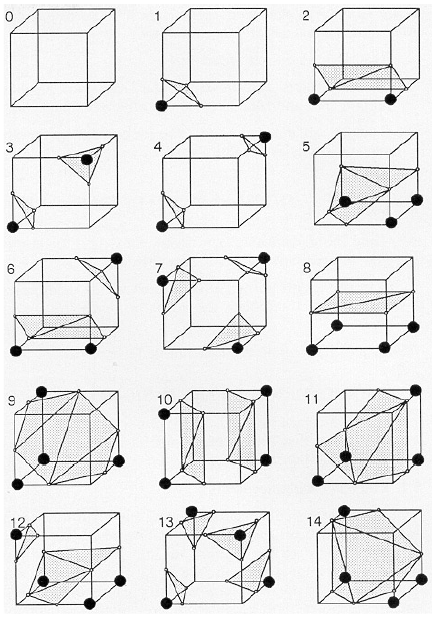Marching Cubes Algorithm
CS-116B: Graphics Algorithms
Instructor: Robert Bruce
Spring 2017
SLIDE 1: Marching cubes algorithm
- Approximating surface of 3D surfaces through volumetric sampling using cubes and state tables.
- Patented in June 5, 1985.
- Note: alternative technique called marching tetrahedrons
- – Uses irregular tetrahedrons instead of cubes.
SLIDE 2: Marching cubes algorithm
- Marching cubes algorithm advantage:
- – Surface reconstruction based on state tables.
- Cube size impacts surface resolution.
- – Quality versus speed.
- – Slower: small cube = fine surface detail
- – Faster: large cube = course surface detail
SLIDE 3: Marching cubes algorithm
- Construct 3D surface based on sampling with cubes!
- Cubes are then sliced into triangular states.
- Each triangular state determines:
- – Which parts of cube are on the surface of the metaball?
- – Is entire cube consumed by metaball?
- We are recreating the irregular surface of a 3-dimensional volumetric metaball.
SLIDE 4: Marching cubes algorithm: cases

Image source: Marching cubes: A high resolution 3D surface construction algorithm, p. 165.
SLIDE 5: Marching cubes: grid size samples

Image source: 3D Object Morphing with Metaballs, page 5.
SLIDE 6: Hints
- Implementing the marching cubes algorithm…
- – Define every possibly triangulated cube state in an array (see marching cube algorithm paper).
- – How many vertices are on a cube? Build a vertex list in an array.
- – How many edges are on a cube? Build an edge list in an array. Reference the edge list from your vertex list.
SLIDE 7: For Further Reading
Kommareddy, S., Siripun, J., & Sum, J. (n.d.). 3D Object Morphing with Metaballs. Retrieved from https://www.evl.uic.edu/creativecoding/cs488/finalprojects/metaball/metaball.pdf
Wyvill, G., McPheeters, C., & Wyvill, B. (1986). Data structure for soft objects. Visual Computer 2(4), 227-234.
Robert Bruce
Research
Courses
Spring 2017, CS-116B:
Lectures:
- Marching cubes algorithm
- Marching squares algorithm
- Building a physics engine
Assignments:
- Assignment 1: Marching squares
- Assignment 2: Particle explosion simulation
- Assignment 3: Rope simulation with gravity and collision detection
- Assignment 4: Cloth simulation with gravity
- Assignment 5: Cloth simulation with gravity, wind, and collision detection
